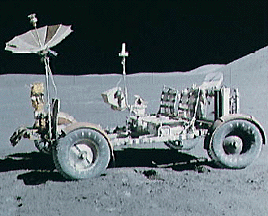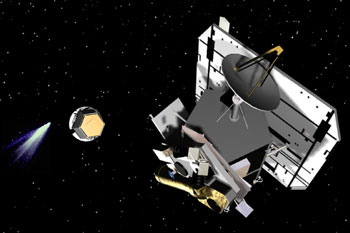Image of Mariner 4
Click on image for full size
NASA/JPL
Mariner
The 10 Mariner missions of the 1960's and early 70's were all flybys designed to visit nearby planets in our solar system. Seven were successful, reaching Venus, Mars, and Mercury.
Mariner 2, launched in 1962, was the first spacecraft to go to Venus, sending back information on its high surface temperature. The fifth Mariner mission also visited Venus and performed experiments on its atmosphere.
Our first close-up glimpse of planet Mars was from Mariner 4 in 1965, and revealed a terrain covered with craters. Mariners 6,7, and 9 also reached the red planet, returning information on its composition and photographs of its two moons.
The Mariner 10 mission was the last in the Mariner sequence, and visited both Venus and Mercury.
Some of the data returned from these spacecraft are shown in the image archive below.
You might also be interested in:

Mariner 10 was launched on Nov. 3, 1973, intended as a flyby of planets Venus and Mercury. It passed Venus in February of 1974, returning over 4000 photographs of it's thick cloud cover and information
...more
The Hubble Space Telescope (HST) is really neat! It was first launched in 1990, but scientists started building it in the 1970's! We have found all kinds of objects like stars, nebulae and galaxies. The
...more
Apollo 11 was the first mission that landed a person on the moon. On July 16, 1969, the U. S. rocket Saturn 5 was launched carrying the lunar landing module Eagle. The Eagle was released and it reached
...more
Apollo 12 was launched on Nov. 14, 1969 and arrived at the Moon three days later. Astronauts Charles Conrad and Alan Bean descended to its surface, while Richard Gordon remained in lunar orbit aboard the
...more
Apollo 15 marked the start of a new series of missions from the Apollo space program, each capable of exploring more lunar terrain than ever before. Launched on July 26, 1971, Apollo 15 reached the Moon
...more
NASA chose Deep Impact to be part of a special series called the Discovery Program. This program is for cheap, scientific projects. In May 2001, NASA said it was ok to start with mission development for
...more
Galileo was a spacecraft that orbited Jupiter for eight years. It made many discoveries about Jupiter and its moons. Galileo was launched in 1989, and reached Jupiter in 1995. The spacecraft had two parts.
...more















